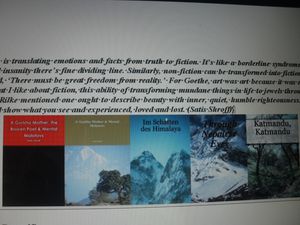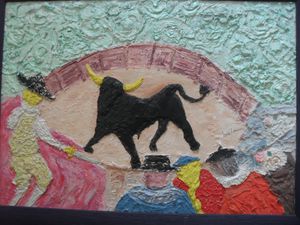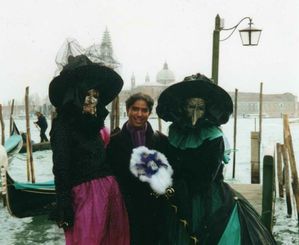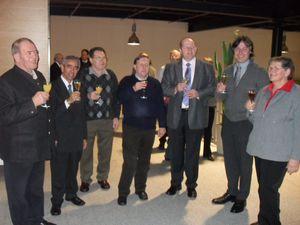Zeitgeist: Angst, Religion, Ideology (Satis Shroff)

After Arundhati Roy’s ‚God of Small Things,’ Kiran Nagarkar, an author from Mumbai, came up with ‚God’s Smaller Warriors,’ which didn’t make it to the Man Booker Prize.
Nagarkar’s book is about a protagonist named Zia Khan and his brother Amanat. Even though Zia changes his religion a couple of times, he remains an extremist at heart. The story deals with extremism in this era of globalisation, using a Bollywood screenplay with dancers from this Schwarzwald metropolis and eight actors. Zia is depicted as a gifted mathematician who changes not only religions, but also continents to study in an elite English university, then as a radical Islamist and a fiery Catholic who’s against abortion in the USA. His brother Amanat, who is the personification of empathy and reason, tries to bring his fanatic brother to his sense by writing letter to him. The book reads like a Bollywood film. Nagarkar’s other book, which has been published in German, bears the title ‘Die Statistan,’ deals with India’s biggest film-industry based in Mumbai. The writer quotes Kabir, the Indian mystic of the 15th century, which is the tenor of his work: ‘There is only one God and his name is life.’
Green City Freiburg is staging Nagarkar’s ‘Gottes kleiner Krieger’ as a Bollywood musical in the Freiburger theatre. The musical is directed by the Basle-born Jarg Pataki who has brought in dialogues with changing scenes, love-songs, an orchestra with six musicians and 30 amateur dancers and the choreograph is Aakash Odedra. Jarg Pataki is of the opinion that religion is actually not the cause of extremism. He says the world would be much better without people who dictate to other what they should do and believe in. Sounds like wishful thinking,eh?
The reality in Germany is different. The Klu-Klux-Klan has raised its ugly head in Schwäbish Hall recently, and the policewoman Michele Kieswetter was shot dead in the year 2007. Ms. Kieswetter’s execution as well as the murders of Turkish and Greek migrants are thought to have been committed by the NSU-trio Uwe Mundlos, Uwe Böhnhardt and Beate Zschäpe., who belong to the national Socialist Underground, a rightist terror organisation. The Federal Criminal Department (BKA) is working together with the Landeskriminalamt (LKA). The motive was racism and right extremism in nature. Another rightist organisation in Schleswig Holstein has officially the right to use the slogan ‘We are the Folk’ (Wir sind das Volk) according to the German Patent-and Markenamt in Munich.
In a razzia carried out in 1998, the Federal investigators found a bomb-producing garage, which was rented by Ms. Schäpe, who now faces charges in Munich. The trio from Jena, who were active in the neo-nazi scene, left Jena and sought refuge with Chemnitzer rightist comrades. A series of murders began on September 9, 2000 starting with shots at a flower-seller in Nuremburg. The trio rented an apartment in 2001 in Zwickau, where more executions were carried out. However, on November 4, 2011 Böhnhardt and Mundlos shot themselves in Eisenach in a caravan after a bank robbery.
What can we expect from the current NSU-trial in Munich’s Oberlandesgericht? Certainly not why the NSU-murder series was not investigated into for such a long time. The case won’t throw light on the inactivity of Federal security officials. What we can expect is a court-case in which the guilt of the involved persons will be measured and jurisprudent peace guarantee to some extent. This, in turn, can be of help to the victims’ families to come terms with what they have experienced and to give back the dignity to those killed, and who’s only mistake was to eke out an honest living in the former East Germany.
In this context it is interesting to note that PEN, which is an international organisation that fights for the freedom of speech and persecuted authors, has demanded the German government and the European Parliament to see to it that democracy and human rights in Hungary, country where 100,000 Jews live, and where there is open hatred against its Jewish citizens at the government level.
Whereas Nagarkar’s protagonist Zia Khan changes religions like a chameleon its color, the neonazi brides have given up their Springer boots with white laces and bald heads, and have decided to adapt themselves to their German environment, the way the Führer once suggested in the hoary past. It’s not only the women but also the men who’re adapting themselves. They wear dirndls and traditional clothes and don’t go about shouting nazi-paroles but use subtle methods very active and are potential executors of rightist terror operations against foreigners. And the terrorist Beate Schäpe ‘is only the tip of the iceberg,’ according to professor Michaela Köttig 47, who teaches at the Fachschule Frankfurt and is carrying out a research-network on ‘Women and Rightist Extremism.’ Ms. Köttig works closely with the writer and journalist Rena Kenzo.
Germany’s official organ for the Protection of the Constitution (Verfassungsschutz) took little, if any notice of the activity of rightist women in the country which led to fatal consequences in the case of Beate Zschäpe.
If you see a German woman wearing a blue and red string tanga with the number 88 in white, it means the eighth alphabet ‘HH’ which means ‘Heil Hitler!’ And if you see a mag with the words ‘Verboten Gut’ with the caption ‘Deutsch ist Geil’ it’s not an erotic, but a nazi-mag. The mag provokes discussions on national feminism and nazi-ideology. The modern rightist extremism seems to be a magnet for girls who want to against their parents, society and don’t want to show conformity with their Christian, conservative parents. The girls organize camaraderie meetings, love to discuss about national feminism, and give the neonazi movement a much-needed semblance of normality, like Beate Zschäpe did. The neo-nazi girls appear sexy and have management qualities.
On May 10, 1933 the National Socialists burned books in 21 university towns in Germany as a brutal and aggressive protest against the freedom of the printed word. There were funeral pyres in which books of the 131 non-Teutonic intellectuals were burned with glee. In the town of Freiburg the Nazi philosopher held a speech on the necessity of book-burning in November 1933, but the heavy rains prevented the outdoor book-burning. The authors whose books were burned, much like Salman Rushdie’s ‘Satanic Verses’ in Iran, were: Heinrich Heine, Wedekind, Stefan Zweig, Alfred Kerr, Hans Johst, Bertold Brecht, Feuchwanger, Karl Marx, Franz Werfel, Eric Mühmann to name a few.
The young students of the Deutschen Studentenschaft carried out this intellectual selection of so-called ‘un-German books’ to be burned. They did it to protest against the so-called ‘decadence, and loss of order and customs in the family and state.’ The book-burning in university-towns was also to create more terror and fear, and to make it clear that other opinions were not to be tolerated. The people began to have angst to express their thoughts to strangers, neighbours and even their own children, who were enthusiastic members of the brown-shirts. The fear of being denunciated by their own children and neighbours was rampant.
Modern Germany’s youth are well-travelled, chic and know what they want in life. Through travel they have widened their horizons, and the school authorities do a lot to make them think and reflection about the Brown Past during the Third Reich of their Grandparents. It is when there’s the fear of losing jobs, competition from the EU countries, open-borders and thus freedom of movement that make the underdogs in countries like Germany, Switzerland and Britain free for the conservative, rightist ideology. Travel, tolerance, compassion, mutual respect and dialogue is the solution. Otherwise we haven’t learned from History.









